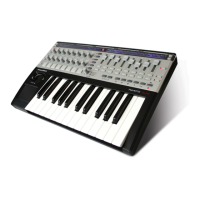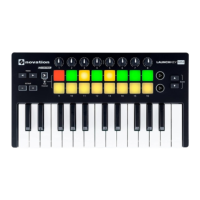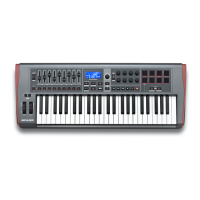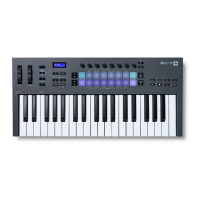23
Amplitude and Filter envelopes, but they can be assigned at will to control many other synth
functions, including most oscillator parameters, filters, EQ and panning among others.
The assignment of Envelopes 3 to 6 to other synth parameters is performed in the Modula-
tion Menu (see page 25 for full details). In order to audition their effects, you must first
open the Modulation Menu and set Modulation Patch 1’s Source to Env3 and the
Destination to a parameter of your choice (e.g. Global Oscillator Pitch – 0123Ptch).
The arrangement of parameters for Envelopes 3 to 6 is identical, and the arrangement
closely follows that of Envelopes 1 and 2 (Amplitude and Filters). Although denoted as
Envelope 3, the parameter summaries below apply equally to Envelopes 3, 4, 5 & 6, so are
not repeated.
The actual function of Envelopes 3 to 6 will obviously depend on what they are routed
to control in the Modulation Menu. However, the derivation of the envelope parameters
themselves follow those already described for the Amplitude and Filter envelopes, with the
exception of the Delay parameter (Page 1, RE5), whose function is described below.
RE1: Envelope 3 Attack Time
Displayed as: E3Att
Initial value: 10
Range of adjustment: 0 to 127
RE2: Envelope 3 Decay Time
Displayed as: E3Dec
Initial value: 70
Range of adjustment: 0 to 127
RE3: Envelope 3 Sustain Level
Displayed as: E3Sus
Initial value: 64
Range of adjustment: 0 to 127
RE4: Envelope 3 Release Time
Displayed as: E3Rel
Initial value: 40
Range of adjustment: 0 to 127
RE5: Envelope 3 Delay
Displayed as: E3Delay
Initial value: 0
Range of adjustment: 0 to 127
This parameter delays the start of the entire envelope. When a key is pressed, its note
sounds normally, with Envelopes 1 and 2 acting as they are programmed. But any further
modulation effects triggered by Envelopes 3 to 6 will be delayed by a time set by the Delay
parameter. The maximum value of 127 represents a delay of 10 seconds, while a value of
about 60~70 represents a delay of approximately 1 second.
RE6: Envelope 3 Repeat
Displayed as: E3Repeat
Initial value: 0
Range of adjustment: 0 to 127
RE7: Envelope 3 Touch Trigger
Displayed as: E3TTrig
Initial value: Off
Range of adjustment: Off, T1ReTrig to T8ReTrig, T1Trig to T8Trig, T1Enable to T8Enable
RE8: Envelope 3 Multi-trigger
Displayed as: E3MTrig
Initial value: Re-Trig
Range of adjustment: Legato or Re-Trig
Envelope 3 parameters (Page 2)
RE1: Envelope 3 Attack Slope
Displayed as: E3AtSlp
Initial value: 0
Range of adjustment: 0 to 127
RE2: Envelope 3 Decay Slope
Displayed as: E3DcSlp
Initial value: 0
Range of adjustment: 0 to 127
RE3: Envelope 3 Attack Track
Displayed as: E3AttTk
Initial value: 0
Range of adjustment: -64 to +63
RE4: Envelope 3 Decay Track
Displayed as: E3DecTk
Initial value: 0
Range of adjustment: -64 to +63
RE5: Envelope 3 Sustain Rate
Displayed as: E3SusRat
Initial value: 0
Range of adjustment: -64 to +63
RE6: Envelope 3 Sustain Time
Displayed as: E3SusTim
Initial value: 127
Range of adjustment: 0 to 127
RE7: Envelope 3 Level Track
Displayed as: E3LvlTk
Initial value: 0
Range of adjustment: -64 to +63
Common Envelope Parameter
See page 21. The Track Reference Note parameter is available at RE8 on Page 2 of the
menu for every Envelope.
lfoS
The UltraNova has three separate Low Frequency Oscillators (LFOs). These are desig-
nated LFO1, 2 and 3, are identical in terms of features, and can be used freely to modify
many other synth parameters, such as oscillator pitch or level, filters, panning, etc.
The assignment of LFOs 1 to 3 to other synth parameters is performed in the Modulation
Menu (see page 25 for full details). In order to audition their effects, you should first open
the Modulation Menu and set Modulation Patch 1’s Source to Lfo1+/- or Lfo1+
*
and the
Destination to a parameter of your choice. Note also that the Depth control on this menu
(RE6) determines the amount of LFO modulation applied to the Destination parameter,
and increasing this value will have a different effect depending on what the Destination pa-
rameter is, but can generally be taken to mean “more effect”. The interpretation of negative
values of Depth will also depend on the chosen Destination parameter.
The LFO section has its own set of three LEDs, one per LFO. These monitor the output of each
LFO to provide a convenient visual reference as to their frequency, waveform and phase.
Pressing the LFO button [16] opens the LFO Menu, which has two pages for each LFO.
One of the SELECT buttons and one of the PAGE buttons will be illuminated, indicating
that more than one LFO is available to be controlled and that further menu pages are avail-
able. A total of 12 parameters per LFO is displayed for adjustment, eight on Page 1 and
four on Page 2. Because the three LFOs’ parameters are identical, only the functions of
LFO1 are described.
*
Selecting Lfo1+ as the source makes the LFO vary the controlled parameter in a
positive sense (i.e. increasing) only. Selecting it as Lfo1+/- varies it in both a positive and
a negative sense. These options, and others related to them, are discussed in greater detail
at page 25.
LFO 1 parameters (Page 1)
RE1: LFO 1 Rate
Displayed as: L1Rate
Initial value: 68
Range of adjustment: 0 to 127
Rate is the oscillator’s frequency. A value of 0 disables the LFO, and most musical effects
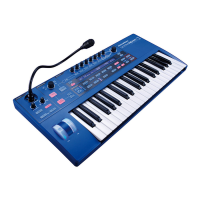
